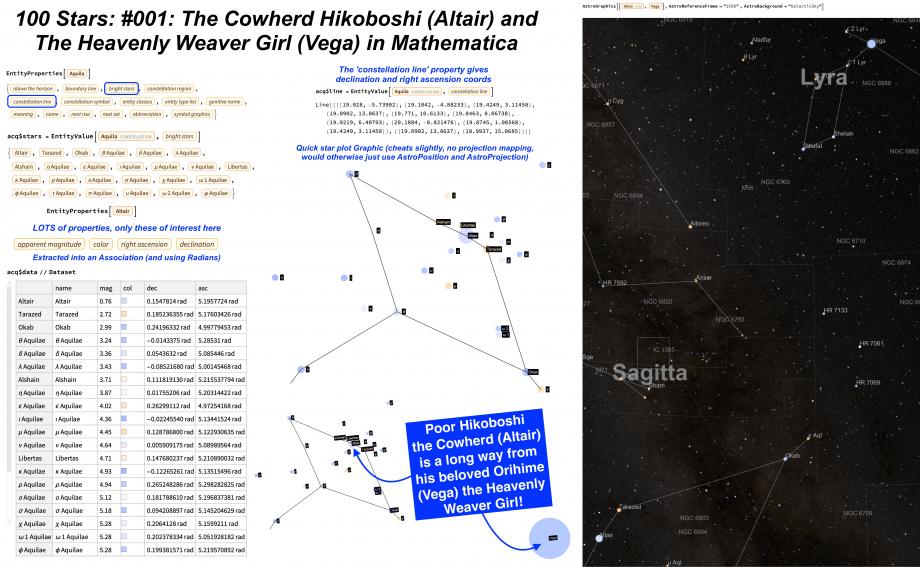Tags and keywords
You may have heard of the astronomy book 'A History of the Universe in 100 Stars' by Florian Freistetter, also available in English as an audiobook. See the trail introduction for links.
Dr Darren says:My fun science project for 2025 is to spend some Sunday evenings exploring some aspects of some of the 100 featured stars and other objects in Mathematica.
The 1st featured star is Altair in Aquila, known in Japanese as Hikoboshi through the tale of The Cowherd Hikoboshi (Altair) and The Heavenly Weaver Girl (Vega). You can read the story in the book, but the gist is they are separated but bridged by the Milky Way.
My Mathematica aim was to explore EntityProperties and create a simple star plot of the constellation Aquila, showing the star names and their colours, along with an overlay of the constellation line, and to show Vega (which is not in Aquila) to show how The Cowherd Hikoboshi (Altair) and The Heavenly Weaver Girl (Vega) are separated.
A CTRL+= in a Notebook quickly fetches from Wolfram Alpha the Aquila constellation Entity, for which for this exercise the EntityProperties 'bright stars' and 'constellation line' are of interest.
Altair is the 1st EntityValue amongst the 'bright stars'.
Each star Entity has LOTS of EntityProperties, only the following are of interest here: 'apparent magnitude', 'color', 'right ascension', and 'declination', and we'll also need the CommonName of each star Entity. To make things easier I extracted the properties of interest in an Association, and converted right ascension and declination to Radians.
The quick star plot cheats a bit because it doesn't handle the projection, which is rough enough for smaller constellations (and there's little point in reproducing what is now fully handled by AstroPosition, AstroGraphics, and AstroProjection, but I wanted for this case to explore the Entity values directly).
The 'constellation line' data (requires conversion from right ascension in hours of right ascension and declination in angular degrees) is used to create the overlay.
Another CTRL+= fetches Vega easily, and then adding it into the star plot we see that poor Hikoboshi The Cowherd (Altair) is indeed a long way from his beloved Heavenly Weaver Girl (Vega).
On the right you can see the full fetch from:
AstroGraphics[ { Entity["Star", "Altair"], Entity["Star", "Vega"]},
AstroReferenceFrame -> "ICRS",
AstroBackground -> "GalacticSky"
]
It nicely placed both Altair and Vega in one image.
I used the "ICRS" reference frame because at this moment Vega is below the horizon viewed from Sydney, Australia. The International Celestial Reference System is the barycenter of the Solar System (as determined by radio sources).
I used "GalacticSky" so we can see the Milky Way, which in the Japanese tale is the heavenly river Amanogawa, with magpies as interstellar dust clouds.
To read the original tale from author Florian Freistetter visit the links below.


